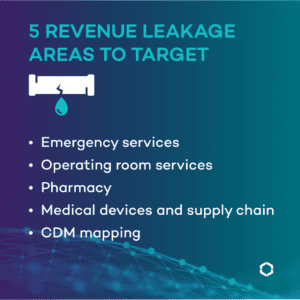As the wellspring of physician and hospital reimbursement, charge capture is a healthcare revenue cycle fundamental. Simple in theory – record every service delivered to secure payment – charge capture can be frustratingly difficult in practice.
Charge capture is a highly complex discipline with ample opportunity for error. It typically involves data from multiple sources and disparate systems requiring manual intervention to retrieve, compile and reconcile. In addition, providers face constantly changing regulations and payer rules that lead to significant revenue leakage – as much as one percent of net patient revenue, according to the Healthcare Financial Management Association.
Ironically, the extreme complexity of charge capture and the process inefficiencies it drives make it an ideal target for boosting revenue across the board. It can also help target the ripest opportunities for additional revenue capture, typically the high-volume departments and areas with complex coding requirements like emergency rooms and pharmacies. As concerns about ongoing workforce shortages, supply chain disruptions and skyrocketing costs grab headlines, it is worth considering that one of the best hedges against inflation is to maximize revenue, and that starts with disciplined charge capture.
How charge capture gets done
At its most basic level, charge capture involves a healthcare professional providing a service and documenting it for billing. There are physician practices and hospitals that still capture charges on paper forms at the point of care. But with electronic health record systems nearly ubiquitous in hospitals, the majority of health systems use EHR software and electronic devices for primary charge capture in most care settings. In between paper and the EHR are third-party software and services that can serve primary or ancillary charge capture roles – managing all charges for the physician and hospital billing systems or helping to identify missing charges not documented in the EHR.
Where the system breaks down
By far the most commonly used healthcare IT system for managing charge capture is the EHR. Just a few years ago, 84% of healthcare organizations reported relying at least partly on their EHR systems for charge capture, with half using it exclusively. However, using the EHR as your sole or primary charge capture system presents some difficulties:
- Health services are delivered across a continuum of care in a variety of settings and locations, and each must equip and prepare to ensure complete capture of all eligible charges
- Constantly changing reimbursement requirements within myriad commercial payer contracts, each with unique requirement, rate and timing considerations, can easily lead to missed charges or undercharges
- Non-integrated clinical and administrative systems often miss billing edits and codes, creating incorrect billing statements that can lead to claim denials and compliance concerns
- Subpar medical coding practices and policies in a system requiring specialized knowledge of thousands of CPT and HCPCS codes and their accurate application are a recipe for increased revenue leakage risk
- Human error can introduce inaccurate charge information into the medical record through faulty data entry and transcription error at the point of care or transposing errors when moving data from one system to another
Meeting the new challenges
As health systems seek to improve their own financial health in the wake of the pandemic, examining and improving charge capture processes should be an essential component of optimizing and accelerating revenue. By adopting and pursuing charge capture best practices, provider organizations can streamline their workflows, create alignment with financial priorities and drive revenue cycle process improvements that make a strong positive impact on the bottom line. While opinions may vary on which are the most important charge capture best practices, there is considerable consensus around the fundamentals:
1. Audit processes early and often
Because the charge capture landscape is fluid and dynamic, regular audits are necessary to help identify potential problem areas before they become serious issues. Finding the underlying causes of revenue leakage can be challenging, but rooting out poor billing practices and finding coding errors begin with a close examination and analysis of current process.
2. Document policies and procedures for alignment
With so many different people and departments involved in capturing charges, clearly defined policies and procedures are necessary to get teams aligned on roles and responsibilities. A well-defined and documented charge capture process gets all participants following the same processes that optimize charge capture and reconciliation.
3. Leverage technology to modernize and optimize
The federal government spent billions of dollars driving EHR adoption for a reason – centralized, digitized medical records dramatically improve both clinical and administrative efficiency. Health systems should consider other technology investments that optimize revenue cycle workflows, including advanced analytics to pinpoint new revenue opportunities and automation to streamline manual, repetitive processes.
4. Educate staff to drive engagement
When it comes to charge capture, like many things, knowledge is power. Hospitals learn this quickly as they lose the institutional knowledge supporting high performance when experienced medical coders leave the workplace. Ongoing education should include all staff entering patient charges, chargemaster staff, clinicians responsible for documenting procedures and services, the payer contracts team and all billing staff. Empowering your teams through education not only leads to increased revenue but it can also lead to a higher performing, more engaged and satisfied workforce.
5. Resolve bottlenecks to speed revenue
Charge lag and extended cycle times are issues when they start to impact timely claim filing. A thorough review of charge capture process steps and how long they take to complete should identify roadblocks and bottlenecks that slow process so they can be addressed.
6. Monitor the chargemaster to reduce risk
Errors in the chargemaster have significant downstream impacts for billing, reimbursement and compliance, none of them good. Systemic mischarges that go unresolved over time present compliance and restitution risks in the case of overcharges, and hard-coded revenue leakage in the case of undercharges.
As healthcare providers look ahead to an uncertain future, charge capture best practices can serve as important compass points to guide your journey to increased revenue and a more stable financial foundation.
To learn how a large Midwestern health system captured $9 million in new revenue using R1 Charge Capture, download the case study,






